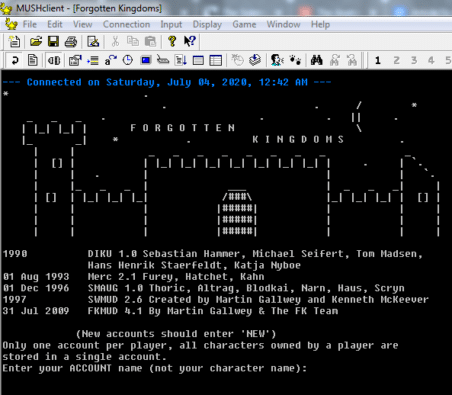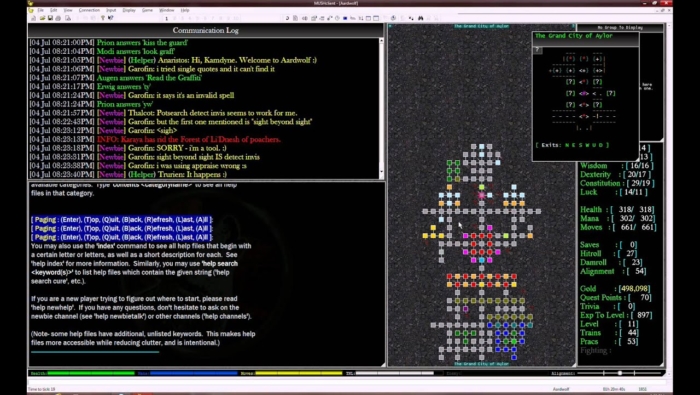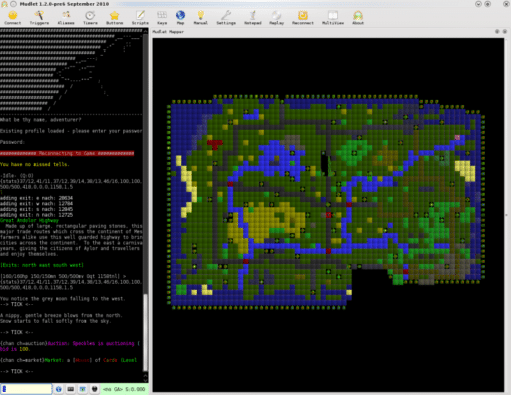The Complete History of Role-Playing Games (RPGs): Part 8 – Stuck in the MUD
Role-playing games, or RPGs, form one of the most lucrative genres of computer games in the world today, demanding tens of hours of dedicated play from gamers and rewarding them with rich storylines, memorable characters and an often emotional escape into other worlds.
How did RPGs come to be? What are their origins and how did this once-minor pastime of interactive storytelling become an industry behemoth? Here at Ultimate Gaming Paradise, we have some of the answers, brought to you in this growing series of articles.
Come with me now, back to the early 90s and the dawn of the internet. It’s time to get our feet dirty.
Episode Eight: Stuck in the MUD
Google the start of the world wide web, and you’ll be told it all happened in 1991–but that’s not exactly true. Yes, the first genesis of web pages happened on a technical level then, but it was years before typical computer enthusiasts actually started to engage with them. For the first half of the 1990s, the internet was still a very fledgling thing, typically constrained to businesses and colleges—the idea that you’d sit at home and ‘log in’ to anything online was alien.
Come 1994, and most of us were still talking about the internet in the same way that we’re talking about self-driving cars today. Oh, we know they’re out there somewhere but no one actually has one.
But then a day would come when you would find a place to access this bright, unknowable world… and life changed forever.
You Are Not Alone
Remember the text adventure game? Episode two of this series deals with them in detail, the fun interactive storybooks where you could choose what the protagonist would do next. ‘Open door’ you would say, and the door would open. ‘Enter kitchen’ you would type, and into the kitchen you would go.
But you never met anyone else.
Oh, sure, there were non-player characters (NPCs) and some adventure games did a fairly reasonable job of programming those NPCs with some rudimentary artificial intelligence (or at least, conversational responses), but it wasn’t as if they were going to really affect your gaming experience. Certainly, none of them would go off on a tangent and start discussing last night’s TV, or their favourite books.

Imagine if that wasn’t the case though. Imagine if you weren’t the only person playing this text adventure game and that there was someone out there in the magical computer aether who was also sat in front of a screen, typing that they’d like to go north, and pick up the sword.
Oh, the possibilities!
And then it happened.
Sending Text Across the World
Anyone with even a passing interest in how computers and the internet work, knows that the more data you need to send the slower it is, and the better your connection needs to be. In the early days of the internet, the idea of broadband data speeds or WiFi were crazy-future-speak. In the 1990s, users were lucky if they could get a decent 56k rate, which, in today’s terms means connections were really, really, really slow.
Sending pictures took time, but text is so very light. Compared to a single screenshot, a few lines of text is minuscule in data terms, so that’s what the early internet did well—it sent text. And it could do that pretty rapidly.
Luckily, adventure games were all text, and the inputs from players were also all text. It all just made sense.
Dawn of the Multi-User Dungeon
The first MUD was called MUD, or MUD1. It stood for Multi-User Dungeon, and it was actually written more than a decade earlier than the time described above. Roy Trubshaw and Richard Bartle, students at Essex University, coded a multi-player text adventure game that became available on the UK CompuNet network in the 1980s.
Expanding on the basic story adventure, MUD included code to deal with combat between the player and the adversaries in the adventure, a feature that is common across all MUDs and brings a greater element of the traditional role-playing game to the text adventure origins.
It was superseded some years later by AberMUD, named after Aberystwyth University where it was developed. By now, the Usenet, an early version of the internet, was in regular use in universities across the world and AberMUD spread far wider than its predecessor. Still not quite far enough to be considered ‘public’, but certainly no longer private.
Tiny MUD, written by Jim Aspnes in one weekend, it arrived in 1989 and was really responsible for a more widespread engagement and understanding of the genre.
But it was LPMUD, written by Lars Pensjö and a large group of helpers in 1989 that dominated the 1990s multi-user gaming community. It did this by adding one key feature to the fledgling genre—it was extensible, allowing the users the ability to add and develop the world themselves.
Living in Kingdoms, on Planets, and Elsewhere in Cyberspace
Until LPMUD, players were constrained to playing the game the developers had built. While this was definitely fun, it was also quite constrained and only the very hardcore players remained for extensive amounts of time.
LPMUD brought with it the ability for the players to be promoted to “Wizard” status, giving them rights to further develop the platform itself. Built in LPC, a user-friendly programming language with a gentle learning curve, LPMUDs were easy to design and develop, and often had large teams of users eager to generate content for the game they loved.
The core engine provided all the tools for any number of settings literally limited only by the development team’s imagination. Many fantasy settings appeared, as did science fiction worlds, cyberpunk environments and fanfiction versions of popular settings; Star Wars, Discworld, Neuromancer, Star Trek, Cthulhu, Lord of the Rings, Dune and more.
And with each, a dedicated fan-base, willing to spend hundreds of hours playing and improving the game.
The Addictive Quality of Online Gaming
It was an early time for online games, filled with text-only adventures run through obscure protocols such as Gopher or Telnet, but already the addictive quality of multiplayer gaming began to be seen.
When a world opens up in front of you that comes with endless exploration, plus engaging and entertaining stories and quests, that can be absorbing enough, but add real people to the mix and things become quite different.
Human beings are social animals; we all crave friendship and communication. For many, the lure of the MUD was incredible. It combined all the elements of a great adventure game with the open discussion of a chatroom. Get bored playing a quest? Take a break and talk to someone, maybe help out a new player, or just relax in your virtual home and listen to the chatter that’s going on around you. Plus, if you get tired of those distractions, you can always go WIZ and design some more of the game; maybe a magic staff, or a detailed church with stained glass windows and aggressive gargoyles.
The MUD became where you gathered socially, where you played and relaxed, where you felt like an experienced adventurer, on hand to help the young, and where you could make a mark shaping and improving it for others.

It was a new virtual life, and though the term wouldn’t be invented for two decades, it was also one of the earliest examples of internet FOMO. Fear that you weren’t online to keep up to date with the latest development from your friends, or that you missed some important update, was niggling to some and all-consuming for others.
Many became, quite seriously, stuck in the MUD.
Isn’t This a Role Playing Game? Shouldn’t We Be Role Playing?
You stand outside the guildhall for LimitlessHackers. The street is strewn with rubbish, bits of discarded metal, paper flitting like leaves in the wind, and the tell-tale signs of Antak addiction—used pods in clusters by the clogged drains.
Maxor is here.
Maxor: Hey, Tantorlus, how are you?
Say: I’m good, thanks.
You: I’m good, thanks.
Maxor: Did you see the football last night?
Sigh
You sigh.
Say: RP Server, Maxor.
You: RP Server, Maxor.
Maxor: Sorry, yeah. LOL, my bad.
For many, the game had to be pure, and that meant never stepping out of character to say something that was RL (real life). On the basic level, this meant simply ‘don’t say anything that Maxor wouldn’t say’, but for some (especially those in fantasy settings) it led to far too many ‘forsooth’s and ‘yea’ing as they tried desperately to speak the way they believed a knight in ancient times might have done. Cool, right?
Role-playing servers that stuck to strict adherence to this rule meant it was much less chatroom and more gameplay, but that didn’t mean fewer fans–with many players flocking to them eager to show off their typed acting skills as a Tolkien-esque elf, or grunting low-IQ barbarian.
It was here that you’d get an experience much closer to that Dungeons and Dragons ideal, a real moment of atmospheric interactive storytelling. Like choosing your setting, choosing the degree of role-playing intensity, meant that when you found a MUD that suited you, that was probably where you stayed.
Enjoyably, as MUDs exploded worldwide throughout the 1990s, there was definitely a place for everyone.
The Murky World of Playerkilling
As soon as you bring people together in any sort of game environment, you get one group that competitively wants to beat up another. It’s human nature.
Thankfully, MUDs are there to cater to the type of player looking to flex his virtual muscles. With combat systems in place to deal with player-vs-monster encounters in the games, it only takes a few tweaks to allow player-vs-player (PvP) experiences.
Equally, thankfully, PvP is typically either an opt-in event, meaning those who don’t want to be hunted down by a player with vastly more experience and equipment than them can stay away from danger, or set up on servers that clearly mark themselves as full PvP/PK environments.
Looking Behind the Curtain – Meeting the Wizard
Dungeons and Dragons, in its tabletop form, is a very social game. You typically have five to seven players who meet regularly, and chances are the hobby opens its enthusiasts to other social gatherings.
Similarly, MUDding brought people together in real life. For many, chatting daily via in-game messages grew, friends were made, and meetings scheduled. Plenty of MUD enthusiasts in the 1990s took the opportunity to meet up, have parties and, in many cases, build friendships and relationships that still exist today.

Of course, for some that brings disappointment as they realise that despite Thrangor the Wise’s online identity, he’s actually a slightly introverted physics student from Blackpool, and the final reveal is all a bit Wizard of Oz in its anti-climax. For others though, they are more than happy with who they find on the other end of the keyboard; a like-minded individual with who they’ve been sharing some, if not all, of their dark secrets for months (and yet they still agreed to meet!).
Caveats about meeting strangers on the internet aside, the various MUDs across the world did a great job in bringing people together for a decade, which can only be a good thing.
Continued Evolution
“Wouldn’t it be amazing if we could play a MUD but with some really good graphics, and fighting controls?”
So said every single MUD player for years. MUDs continued to develop as technology and programming improved. There was an advancement with MOOs, embracing the growing trend (at the time) of object-oriented programming, but the main advancements came when multi-user dungeons went to massively multiplayer online role-playing games. The dawn of MMORPGs was on the horizon.
But that’s a story for another time.
Playing in the MUD Today
Good ideas are hard to kill. MUDs were always about easy access. 99% of them were free, and all you needed was the most basic of hardware, capable of connecting to the internet and displaying text. Of course, today your phone is more than up to the task.
There are some diehards who still maintain MUD servers in these more modern times. From those who just saw no need to turn them off, to others who have an active schedule of updates and maintenance, there are still hundreds of MUDs in existence. For an up-to-date list of active MUDs, look no further than MUDStats.com.
Coming Next…
Of all RPGs, there is one game that stands out as a major moment; a defining point where the genre moved from being the domain of dedicated fans to something a lot more mainstream. Join me next week, when we focus on the incredible impact of Final Fantasy VII.

